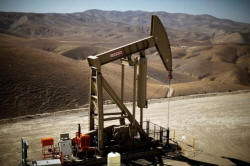|
Undaunted by oil bust,
financiers pour billions into U.S. shale
 Send a link to a friend
Send a link to a friend
 [April 17, 2017]
By Ernest Scheyder [April 17, 2017]
By Ernest Scheyder
HOUSTON
(Reuters) - Investors who took a hit last year when dozens of U.S. shale
producers filed for bankruptcy are already making big new bets on the
industry's resurgence.
In the first quarter, private equity funds raised $19.8 billion for
energy ventures - nearly three times the total in the same period last
year, according to financial data provider Preqin.
The quickening pace of investments from private equity, along with hedge
funds and investment banks, comes even as the recovery in oil prices
<CLc1> from an 8-year low has stalled at just over $50 per barrel amid a
stubborn global supply glut.
The shale sector has become increasingly attractive to investors not
because of rising oil prices, but rather because producers have achieved
startling cost reductions - slashing up to half the cost of pumping a
barrel in the past two years. Investors also believe the glut will
dissipate as demand for oil steadily rises.
That gives financiers confidence that they can squeeze increasing
returns from shale fields - without price gains - as technology
continues to cut costs. So they are backing shale-oil veterans and
assembling companies that can quickly start pumping.

"Shale funders look at the economics today and see a lot of projects
that work in the $40 to $55 range" per barrel of oil, said Howard
Newman, head of private equity fund Pine Brook Road Partners, which last
month committed to invest $300 million in startup Admiral Permian
Resources LLC to drill in West Texas.
Data on investments by hedge funds and other nonpublic investment firms
is scant, but the rush of new private equity money indicates broader
enthusiasm in shale plays.
"Demand for oil has been more robust than anyone imagined three years
ago," said Mark Papa, chief executive of Centennial Resource Development
Inc
Papa referred to the beginning of an international oil price crash in
2014, which took many firms in the shale sector to the brink of
bankruptcy.
Centennial is a Permian oil producer backed by private equity fund
Riverstone. Papa, a well-known shale industry entrepreneur, built EOG
Resources Inc <EOG.N> into one of the most profitable U.S. shale
producers before he retired in 2013.
The chance to further develop the Permian, he said, was enough for him
to come out of retirement to deliver one of its bigger recent successes.
The value of Riverstone's original $500 million investment has grown
nearly four times since Centennial's initial public offering last fall.
'A TON OF PRIVATE CAPITAL'
Riverstone this year copied the Centennial model, putting experienced
managers atop a startup charged with acquiring operations or assets. The
equity fund hired Jim Hackett - the former head of shale producer
Anadarko Petroleum Corp <APC.N> - to run the newly created Silver Run
Acquisition Corp II <SRUNU.O>.
Hedge funds Highfields Capital Management LP and Adage Capital
Management have taken stakes in the new company, which has a valuation
of about $1 billion after going public last month.

Private equity fund NGP Natural Resources XI LP invested $524 million
last fall in Luxe Energy LLC, a shale producer formed in 2015 by former
Statoil <STL.OL> executives.
NGP's investment was effectively a bet that Luxe could repeat its
success of early 2016.
Then, NGP contributed about $250 million to Luxe, which used the money
to acquire land in the Permian - and sold it seven months later for a
double-digit profit.
[to top of second column] |

A pumpjack brings oil to the surface in the Monterey Shale,
California, U.S. April 29, 2013. REUTERS/Lucy Nicholson/File Photo

This
year's drilling rush could be tested if global supplies grow too fast or if
demand cools. The U.S. drilling rig count is rising at its fastest pace in six
years and U.S. crude stockpile are close to 533 million barrels - near an
all-time high and enough to supply the United States for 25 days.
But some investors say even a decline of $10 in the oil price would not dissuade
them.
"There is a ton of private capital to invest in the U.S. oil industry," said
Gerrit Nicholas, co-founder of private equity fund Orion Energy Partners.
Nicholas said he is comfortable lending even if oil prices fall to $40 per
barrel.
Orion this month helped finance the expansion of a Florida oil-storage terminal,
a move predicated in part on growth in U.S. oil exports. Since the U.S. lifted
its oil export ban last year, crude exports have climbed to about 746,000
barrels per day, according to U.S. Energy Information Administration data.
BETTING ON OPEC'S SELF-INTEREST
The oil industry has seen boom-and-bust cycles since the first well was drilled
about 160 years ago, and industry and government have sought to tame the
volatility for just as long.
Texas regulators set output quotas from the 1920s through the 1970s, a practice
that served as a model for the creation of the Organization of the Petroleum
Exporting Countries (OPEC).

The U.S. boom has caused concern among OPEC member nations ahead of its meeting
next month in Vienna, where they will consider extending oil production cuts
that first took effect in January. Investors believe the cartel's members will
extend the cuts because it is in OPEC's financial interest to prevent a steep
drop in oil prices.
That
likely will keep money flowing to nimble U.S. oil producers and the companies
that provide them with services and equipment. Investors see the United States
as the new swing producer, having the ability to quickly increase supply in
response to any sudden increase in demand.
"The U.S., with its substantial inventory capacity and swing oil producer
status, should see strong onshore activity for the next few years," said Charlie
Leykum, founder of private equity fund CSL Capital Management LLC, in an
interview.
CSL has invested in several oilfield service business in the past year. It
partnered with Goldman Sachs <GS.N> and Baker Hughes Inc <BHI.N>, for instance,
to create a shale services company.
Centennial's Papa expects the flood of fresh capital to push U.S. production up
23 percent to 11.3 million barrels a day (bpd) by 2020, based on strong demand
for oil.
"We're still in a hydrocarbon-based economy," said Papa.
For a graphic on private equity investment in U.S. energy, click http://fingfx.thomsonreuters.com/gfx/rngs/USA-SHALE-FUNDING/010040ML1DV/index.html
(Reporting by Ernest Scheyder; Editing by Gary McWilliams, Simon Webb and Brian
Thevenot)
[© 2017 Thomson Reuters. All rights
reserved.] Copyright 2017 Reuters. All rights reserved. This material may not be published,
broadcast, rewritten or redistributed. |